REG LANCASTER
REG LANCASTER PICKS HIS FILMS for the Lido Cinema on a desert island near you.
When Lee first asked me to list my five favourite films. I almost refused. Only FIVE ! After some hard politicking, and some abject grovelling I got him to up ten!!
After a lot of fun choosing, here is my list of films that I’d take to the Lido Cinema on the beach of my desert island… and I admit to having changed four already!
10. Bridges of Madison County (Dir. Clint Eastwood 1995)
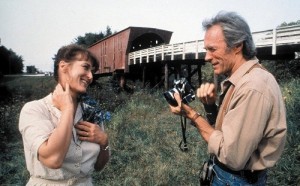
A far cry from Harry Callaghan or Westerns. He plays a photographer who asks directions from farmer’s wife Meryl Streep. They’re terrific in a simple love story that ends when her husband returns. In a downpour Eastwood stops at the only traffic lights in town. The farmer’s car stops, too. She watches Eastwood, who hasn’t seen the farmer’s car before. The lights change. Eastwood turns off to the Highway. Not a dry eye in the house!
9. Richard III (Dir. Laurence Olivier 1955)
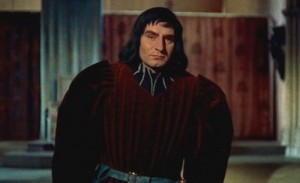
Nothing beats the Bard and though I love the Lancastrian Henry V, I prefer this evil son of York. Richard’s confidential asides to the camera involve us in his scheming, a real break-through. Whenever I’m sickened by glottal stops, dropped aitches and other linguistic twangs and horrors, this one sooths the lug’oles. English as she is spoke, indeed.
8. E.T The Extra Terrestrial (Dir. Steven Spielberg 1982)
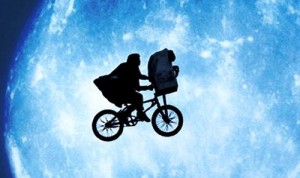
The feel good film of them all. Moments of sheer magic. Even Shrek comes a sad second for ugliest hero in the movies title. The cycle chase one of the best ever, the “keys man” a great villain, and ET and Elliot’s relationship is wonderful. Aaaah!
7. Singin’ in the Rain (Dir. Stanley Donen 1952)
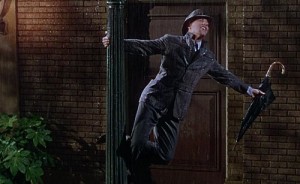
A movie about the movies. The best songs and dance numbers. Sixty years later O’Connor still makes ‘em laugh, Debbie Reynolds is cute as ever and Cyd Charisse’s legs still amaze. As for Gene Kelly …
6. War and Peace (Dir. Sergei Bondarchuk 1967)
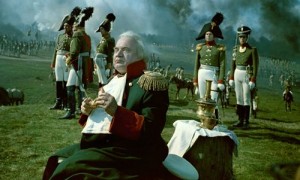
This 10 hour epic (made in Sovscope 70 mm, not in 3 camera Kinopanorama as I believed for many years!) version of Tolstoy’s masterpiece ran in 3 parts in one cinema in Paris for 2 years. Breath-taking. It made such an impression on our daughter Heather that 6 yrs later, living, studying and working in French, where “H” and “Th” sounds are so difficult to pronounce, she began to use ( still does) Natascha as her professional name after the iconic heroine of this film. Many unforgettable scenes. Battles of epic scope.
5. Psycho (Dir. Alfred Hitchcock 1960)
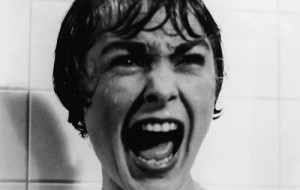
A ground breaker. If you missed its first run, you cannot imagine how uneasy, even scared our “cinema generation” felt once the lead, Janet Leigh, was dead after just 35 minutes. Imitated a thousand times. Never equalled.
4. The Jungle Book (Dir. Wolfgang Reitherman 1967)
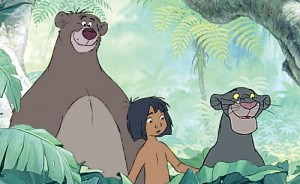
The last film with Walt Disney’s input. I’ve watched it lots of times thanks to grand daughter, Roxane, who loved it as a child, and still watches it every time she visits us. Never fails to make us laugh and feel happy. Fantastic songs, fabulous characters, Baloo, King Louie, Kaa the snake and the Scouser vultures. It’s wonderful.
3. Das Boot (Dir. Wolfgang Petersen 1981)
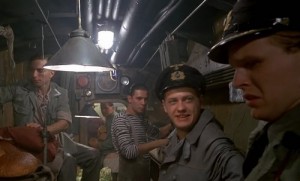
The German TV epic story is seen through a Naval correspondent’s eyes, as he joins a U-Boat crew’s tour of duty leaving Brest. A claustrophobic harrowing tale with a cruel twist. They survive a nightmare trip to make it back just as bombers attack the submarine pens at Brest. Best war film ever.
2. Once Upon a Time in the West (Dir. Sergio Leone 1968)
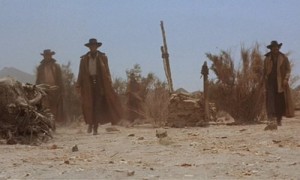
Stylised, stylish and innovative (Henry Fonda as a baddie?) I’d have to have a Western and great music. A brilliant cast, close-ups to die for, haunting themes from Ennio Morricone and a mystery not resolved till the very end. Great.
No1 – Lawrence of Arabia ( Dir. David Lean 1962)
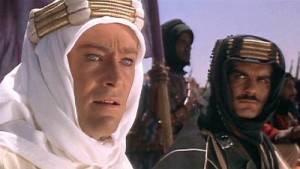
A no brainer. Still the best of British direction, cinematography, editing and acting. Watch it every year at least once. I never imagined I’d ever get to the real Wadi Ramm, so in 1994 bouncing through the desert at dusk in the back of a Land Rover, with Annabelle was an unforgettable experience, both exciting, fun and significant, all thanks to Lean’s masterpiece.
So there you have it – agree or disagree as is your wont. Thanks for reading and don’t forget to check out the lists from other OVFM members!! Click HERE to return to the menu page!

Some interesting titles there Reg. I’ve only seen four of them…. :-\
I’ll be honest I didn’t expect to see any “modern” films in your list, let alone anything like “E.T” but life is full of surprises. 😉
Thanks for sharing this with us. 🙂
War and Peace (Dir. Sergei Bondarchuk 1967) was NOT filmed in 3-panel Kinopanorama, but on 65/70mm film.
My previous post listed my email address incorrectly.
My post is still that War and Peace (Dir. Sergei Bondarchuk 1967) was NOT filmed in 3-panel Kinopanorama but in 65/70mm.
“War and Peace” was not filmed in 3-film Kinopanorama. It was filmed in Sovscope 70, an non-anamorphic 70mm film format. Please correct this information.
Messrs Samuels and Lasher, Thank you for taking the trouble to comment on one of my favourite films. Bonderchuk’s masterpiece may indeed have been made on 70 mm but that’s not really desperately important for me, because I saw the film more than once with my family in an iconic cinema in Paris. It was called the KINOPANORAMA in the Avenur de la Motte-Piquet in the Quinzieme, and was dedicated to showing (in the 60’s) Soviet films, among them War and Peace. That was good enough for me. It had a truly massive screen, and the projection was brilliant for the time. Come to think of it, the fact that War and Peace WAS shot on 70mm may account for the stout support I have always given to the russian 3 screen process’s superiority to Cinerama. After all it was seamless, whereas I once saw the Cinerama Western How the West was Won(?) when one reel got out of synch and a donkey’s head and its body were on different sides of the screen facving different directions for a brief moment!
I’m afraid with a cinema name and reputation like KINOPANORAMA I reckon a dedicated War and Peace fan in entitled to think the Soviet film that he saw there so avidly was made in the process the cinema was named after. I rest my case.
Actually, 3-panel Kinopanorama, which lasted from 1958 to 1963, inclusive, was also plagued by the dividing lines as were CineMiracle and Cinerama. The Russians, however, used a blending mask on their screens as opposed to the so-called ‘gigolos’ on the Cinerama projectors. For this reason the blend lines on Kinopanorama films were somewhat less noticeable. Later on, several Soviet 70mm films were converted to 3-panel Kinopanorama by means of a lens-splitting device. Kinopanorama was re-activated by ‘yours truly’ in 1995 in Australia. An original PSO-1960 Kinopanorama camera was located and restored to contemporary standards. Due to a paucity of funding, and a lack of private donations, we have been unable to carry out various projects over time. We invite you to join The Kinopanorama Widescreen Preservation Association. We have a Facebook page. Go to Google for the website information. Sincerely. John Steven Lasher.
Hi John,
Well, I am surprised and slightly dazzled that you turn out to not just be some technical detail nit picker, but a man with a true knowledge of the subject.
I applaud the uphill task you undertook to salvage and try and restore a Soviet original machine – an act of devotion and indeed heroism – I had a Krasnogorssk 16 mm camera once and you had to be a bleedin Cossack to get it off the ground. Let’s say, it stayed steady and you teetered to operate!
The KINOPANORAMA cinema’s screen was something else- about 25 metres across and quite noticeably curved and yet a standard projection of a 4:3 film like The Cranes are Flying still seemed impressive, even though helf the wall was masked off.
I honestly can’t remember whether War and Peace was dubbed into French or subtitled when we first saw it. When living in French at the time you don’t take account of such details.
An interesting aside is that because the French dubbing industry was highly developed in those days, with each of the Hollywood great stars was always dubbed by the same voice, my kids (now in their 50’s)have never quite accepted screen greats like James Stewart, Cagney and Burt Lancaster’s own voices – much preferring the French actor’s version of their great roles.
Bondarchuk’s War and Peace played on French television on more than one occasion, stretched over a couple of weeks.
Film director’s can work for a lifetime and never come up with a single truly memorable sequences. When the young soldier hero of Cranes are Flying is hit on the battlefield as he spins to the floor it dissolves into a sequence of running up a circular flight of stairs – and fifty tears later I shiver just to think about it. The same with Bondarchuk – the young Natascha, seeing a pair of lovers kissing in the conservatory. After they have left, she runs out into the warm airspace the lovers had occupied,and spins dreamily. Brings tears to the eyes. They don’t make em like that too often, but once is enough!
My god – the mighty Reg Lancaster proven wrong on something! Is this the first sign of the apocalypse? 😛
Well, mate, no one is perfect. We are all entitled to make a mistake now and then. After all, our love of film making comes first.
Two of Reg’s 10 favourite films make my list: “Lawrence of Arabia” at number 1 and “War and Peace” at number 8. I have seen them both in 70mm at the time of their original release. I was living in the United States at the time.
Feel free to check out the other Top 10 lists from our club members to see if they share a fondness for your other favourites. 🙂